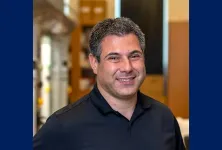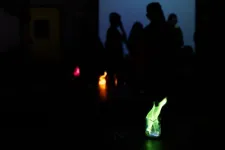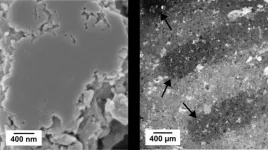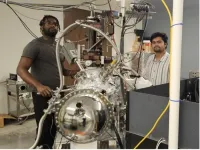(Press-News.org) The study also looked at safety of the AAV-mediated genome editing approach and found it had a good safety profile that includes little off-target effect and no detectable long-term integration of the AAV vector in the genome. “Our research suggested minimal potential risk and supports the feasibility of future clinical applications in humans,” said Wenliang Zhu, PhD, and physician-scientist Wan Du, MD, PhD, members of Chen’s lab at Mass Eye and Ear and first authors on the paper.
The study, led by Zheng-Yi Chen, DPhil, an associate scientist in the Eaton-Peabody Laboratories at Mass Eye and Ear (a member of the Mass General Brigham healthcare system), was published July 10 in Science Translational Medicine.
"Our findings provide a promising pathway for developing treatments by editing for many forms of genetic hearing loss,” said Chen, who is the Ines and Fredrick Yeatts Chair in Otolaryngology at Mass Eye and Ear and an associate professor in Otolaryngology–Head and Neck Surgery at Harvard Medical School. “With further study, our intervention using genome editing could potentially halt or reverse hearing loss progression in affected individuals, including adults."
About one in 500 newborns suffer from genetic hearing loss and currently there are not any approved therapeutics to treat deafness.
In the new study, researchers targeted a specific mutation in the microRNA-96 (MiR-96) gene that causes progressive hearing loss in mice and plays a crucial role in regulating gene expression in hair cells (sensory cells responsible for hearing) of mammals. In humans, this mutation has been identified as a cause of a form of dominant inherited progressive hearing loss called DFNA50. The researchers created a mouse model carrying the mutation that mirrored the progressive hearing loss in humans with DFNA50; by four weeks of age, these models exhibited complete hearing loss at high frequencies.
The team employed a CRISPR/Cas9 genome editing approach to target and disrupt this mutation, that was delivered to the inner ear through an injection of an adeno-associated virus (AAV) carrying the editing machinery. They compared injections at two time points, during early development and adult stages, and demonstrated robust preservation of auditory function in both cases long term, with earlier intervention proving most optimal.
The study also looked at safety of the AAV-mediated genome editing approach and found it had a good safety profile that includes little off-target effect and no detectable long-term integration of the AAV vector in the genome. This suggested minimal potential risk and supports the feasibility of future clinical applications in people.
Chen and his team have designed a construct to contain all known microRNA mutations to be used in humans, and in conjunction with Mass General Brigham’s Gene and Cell Therapy Institute, plan to conduct IND-enabling studies in additional preclinical models in the hopes of moving this treatment approach into a first-in-human clinical trial. Studies like this one show the promise of gene therapy for treating conditions such as hearing loss. Mass General Brigham’s Gene and Cell Therapy Institute is helping to translate scientific discoveries made by researchers into first-in-human clinical trials and, ultimately, life-changing treatments for patients.
This latest research from Chen and colleagues marks a significant step forward in the field of gene therapy for hearing disorders, offering hope for future clinical trials aimed at restoring auditory function in people with genetic forms of hearing impairment. Chen and his collaborators have also conducted clinical trials looking at a different gene therapy approach for another form of deafness, DFNB9 caused by mutations in the OTOF gene. That clinical trial in China has demonstrated positive results in children treated in one and both ears. Chen hopes the technology developed in the OTOF trial, such as minimally invasive AAV delivery into the human inner ears, will accelerate the development of editing therapy into the clinic.
“With more than 150 forms of genetic deafness, our research offers further hope for patients that previously lacked any options beyond a cochlear implant,” said Chen. “These findings suggest a need for more rigorous studies building on proof-of-concept papers like these, to achieve our goal of developing different treatment approaches to target every one of these mutations.”
Authorship: In addition to Chen, Mass Eye and Ear co-authors on the study were Wenliang Zhu, Wan Du, Arun Prabhu Rameshbabu, Ariel Miura Armstrong, Stewart Silver, Yehree Kim and Wei Wei,. Other authors include Yilai Shu, Xuezhong Liu, Morag A Lewis, Karen P. Steel.
Funding: This work was primarily supported by National Institutes of Health (NIH) grants R01 DC016875, R01 DC019404, UG3TR002636, U24HG010423, UH3TR002636 to Chen, the Ines-Fredrick Yeatts Fund, NIH grants R01 DC019404 to Liu and Chen, R01DC012115 and R01DC005575 to Liu, a U.S. Department of Defense (DOD) grant RH220053 to Liu. Partial funding to Steel from the Wellcome Trust, grants 098051, 100669 and 089622.
Disclosures: Chen is a co-founder of Salubritas Therapeutics, and has financial interest in Decibel Therapeutics.
Paper cited: Zhu, W et al. “Targeted genome editing restores auditory function in adult mice with progressive hearing loss caused by a human microRNA mutation.” Science Translational Medicine. DOI: 10.1126/scitranslmed.adn0689
###
About Mass Eye and Ear
Massachusetts Eye and Ear, founded in 1824, is an international center for treatment and research and a teaching hospital of Harvard Medical School. A member of Mass General Brigham, Mass Eye and Ear specializes in ophthalmology (eye care) and otolaryngology–head and neck surgery (ear, nose and throat care). Mass Eye and Ear clinicians provide care ranging from the routine to the very complex. Also home to the world's largest community of hearing and vision researchers, Mass Eye and Ear scientists are driven by a mission to discover the basic biology underlying conditions affecting the eyes, ears, nose, throat, head and neck and to develop new treatments and cures. In the 2023–2024 “Best Hospitals Survey,” U.S. News & World Report ranked Mass Eye and Ear #4 in the nation for eye care and #7 for ear, nose and throat care. For more information about life-changing care and research at Mass Eye and Ear, visit our blog, Focus, and follow us on Instagram, Twitter and Facebook.
END
HOUSTON – (July 10, 2024) – The Controlled Release Society (CRS), the premier international, multidisciplinary society dedicated to the science and technology of drug delivery, has elected Rice University bioengineer Omid Veiseh to its College of Fellows.
The recognition is a prestigious acknowledgement of “outstanding and sustained contributions in the field of delivery science and technology,” according to the organization website.
“I am deeply honored to be elected to the CRS College ...
More than 70 high school students and science teachers gathered at Young Middle School in Arlington this summer to learn about quantum information science (QIS). The annual workshop and camp are part of a national pilot program called Quantum for All led by Karen Jo Matsler, assistant professor in practice and master teacher in the UTeach program at The University of Texas at Arlington.
“Just the word ‘quantum’ scares people, which is why many teachers and school administrators ...
In a groundbreaking effort to tackle the pervasive issue of PFAS contamination in drinking water, a research team at New Jersey Institute of Technology has received funding from the Bureau of Reclamation's Desalination and Water Purification Research program.
This highly competitive grant, awarded to only eight projects out of over eighty applicants, supports their innovative project titled "Enhanced Coagulation for the Removal of Per- and Polyfluoroalkyl Substances using Hydrophobic Ion Pairing Approach Project."
Arjun Venkatesan, associate ...
Most known black holes are either extremely massive, like the supermassive black holes that lie at the cores of large galaxies, or relatively lightweight, with a mass of under 100 times that of the Sun. Intermediate-mass black holes (IMBHs) are scarce, however, and are considered rare "missing links" in black hole evolution.
Now, an international team of astronomers has used more than 500 images from NASA's Hubble Space Telescope — spanning two decades of observations — to search for evidence of an intermediate-mass black hole by following the motion of seven ...
Philadelphia, July 10, 2024 – Despite escalating disaster frequency and severity, guidance for addressing emergency food and nutrition needs is limited. However, existing literature offers insights on how to effectively address emergency food and nutrition assistance. A recent position paper issued by the Society for Nutrition Education and Behavior (SNEB) in the Journal of Nutrition Education and Behavior, published by Elsevier, states that for effective recovery from and resilience to disasters, it is essential that impacted individuals and communities have access to safe, nutritious, and culturally and contextually appropriate foods and beverages, and receive emergency-related ...
A new paper published today in Molecular Biology and Evolution reveals that it's not as straightforward as it might seem. Despite decades of data collection by the United Nations Office on Drugs and Crime (UNODC), which has been valuable to monitor changes in areas occupied by illegal coca plantations in South America, there is no reliable scientific method to distinguish between different types of coca plants.
South American coca plants have been essential to Andean and Amazonian communities for at least 8,000 years. It is within these communities that they are thought to have evolved from wild to domesticated coca plants. Their ...
Solid-state batteries have several advantages: they can store more energy and are safer than batteries with liquid electrolytes. However, they do not last as long and their capacity decreases with each charge cycle. But it doesn't have to stay that way: Researchers are already on the trail of the causes. In the journal ACS Energy Letters, a team from HZB and Justus-Liebig-Universität, Giessen, presents a new method for precisely monitoring electrochemical reactions during the operation of a solid-state battery using photoelectron spectroscopy at BESSY II. The results ...
Solar energy is critical for a clean-energy future. Traditionally, solar energy is harvested using silicon – the same semiconductor material used in everyday electronic devices. But silicon solar panels have drawbacks: for instance, they’re expensive and hard to mount on curved surfaces.
Researchers have developed alternative materials for solar-energy harvesting to solve such shortcomings. Among the most promising of these are called “organic” semiconductors, carbon-based semiconductors that are Earth-abundant, cheaper and environmentally friendly.
“They can potentially lower the production cost for solar panels because these ...
University of Maryland Faculty Physicians has entered into an agreement to lease 17,000 square feet of space at The Village at Mondawmin, which would establish a new community "health village," University of Maryland School of Medicine (UMSOM) Dean Mark T. Gladwin, MD, and Faculty Practice President William F. Regine, MD, announced today. It is part of a larger effort to work in partnership with the West Baltimore community to develop and implement health care delivery based on neighborhood needs and to improve patient access to healthcare.
The Faculty Practice group of ...
In a study examining styles of pitching ideas to audiences, researchers found that pitches promoting radical ideas are better received when framed in concrete and explanatory ‘how’ terms, while progressive ideas do better with abstract ‘why’ style of pitches.
Previous research found that professional audiences, like investors, prefer concrete pitches with how-style explanations, while lay audiences such as students and crowdfunders respond better to ‘why’ style pitches for abstract ideas.
Professor Simone Ferriani, Professor of Entrepreneurship at Bayes Business School (formerly ...






